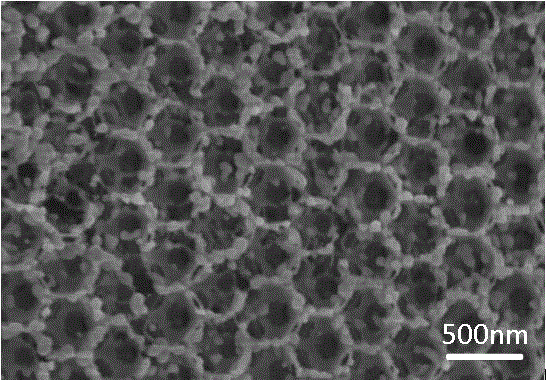Photoelectric analysis method of benzopyrene through in-situ molecularly imprinted functionalized CdS/3DOM TiO2/BDD electrode
A technology of molecular imprinting and photoelectric analysis, applied in the direction of material electrochemical variables, etc., can solve the problems of complex operation and low sensitivity, achieve low background current, good stability and reproducibility, and improve accuracy and precision.
- Summary
- Abstract
- Description
- Claims
- Application Information
AI Technical Summary
Problems solved by technology
Method used
Image
Examples
Embodiment 1
[0027] A functionalized CdS / 3DOM TiO based on in situ molecular imprinting 2 / BDD electrode for photoelectrochemical analysis of BaP, the electrode is constructed by the following steps:
[0028] 1) Pretreatment of BDD electrodes:
[0029] The BDD electrode to be treated was used as the working electrode, the platinum wire electrode was used as the auxiliary electrode, and the saturated calomel electrode was used as the reference electrode. -1 h 2 SO 4 In the solution, use the multi-step potential method (-3.5V, 10s; 3.5V, 10s) to clean for 30min, then take out the BDD electrode, and wash it with deionized water, then put it in aqua regia water bath and boil for 15min, and finally put the electrode in deionized Water, acetone, and deionized water were ultrasonically cleaned for 3 minutes, and then dried naturally to obtain a clean BDD electrode.
[0030] 2) 3DOM TiO 2 preparation of
[0031] Using the hard template method combined with the sol-gel method, the pretreated...
Embodiment 2
[0036] Prepare a series of 0.1 mol L of BaP with different concentrations -1 PBS (containing 0.1 mol·L -1 AA, PH=7.4) standard solution was added to the electrolytic cell as the electrolyte, and the BaP in situ molecular imprinting functionalized CdS / 3DOM TiO prepared in Example 1 2 The / BDD electrode was used as the working electrode, the platinum wire electrode was used as the auxiliary electrode, and the saturated calomel electrode was used as the reference electrode. The above three-electrode system was placed in the electrolyte and stirred for 5 minutes before standing still. Using electrochemical workstation CHI660C, the photocurrent was measured by chronoamperometry under the irradiation of visible light with 0 V bias applied. Firstly, measure the electrode in blank electrolyte solution 0.1 mol L -1 PBS (containing 0.1 mol·L -1 AA, PH=7.4) and the photocurrent after adding different concentrations of BaP standard solutions, and then convert the photocurrent densi...
Embodiment 3
[0038] Measure the blank solution 0.1 mol·L respectively -1 PBS (containing 0.1 mol·L -1 AA, PH=7.4) and 0.1 mol·L containing a certain concentration of BaP -1 PBS (containing 0.1 mol·L -1 AA, PH=7.4) standard solution and 0.1 mol L containing the same concentration of BaP interfering substances (such as benzene, naphthalene, pyrene) -1 PBS (containing 0.1 mol·L -1 AA, PH=7.4) solution was used as the electrolyte, and the three-electrode system as described in Example 2 was used to measure the corresponding photocurrents of different electrolytes, and the respective photocurrent densities of different electrolytes were obtained by calculating the working area of the working electrode. The results show that the photocurrent density in the above-mentioned electrolytes containing BaP and interfering substances has increased to varying degrees compared with the blank electrolyte, but the influence of the photocurrent density on the detection of BaP is less than 22%, whi...
PUM
 Login to View More
Login to View More Abstract
Description
Claims
Application Information
 Login to View More
Login to View More - R&D
- Intellectual Property
- Life Sciences
- Materials
- Tech Scout
- Unparalleled Data Quality
- Higher Quality Content
- 60% Fewer Hallucinations
Browse by: Latest US Patents, China's latest patents, Technical Efficacy Thesaurus, Application Domain, Technology Topic, Popular Technical Reports.
© 2025 PatSnap. All rights reserved.Legal|Privacy policy|Modern Slavery Act Transparency Statement|Sitemap|About US| Contact US: help@patsnap.com


